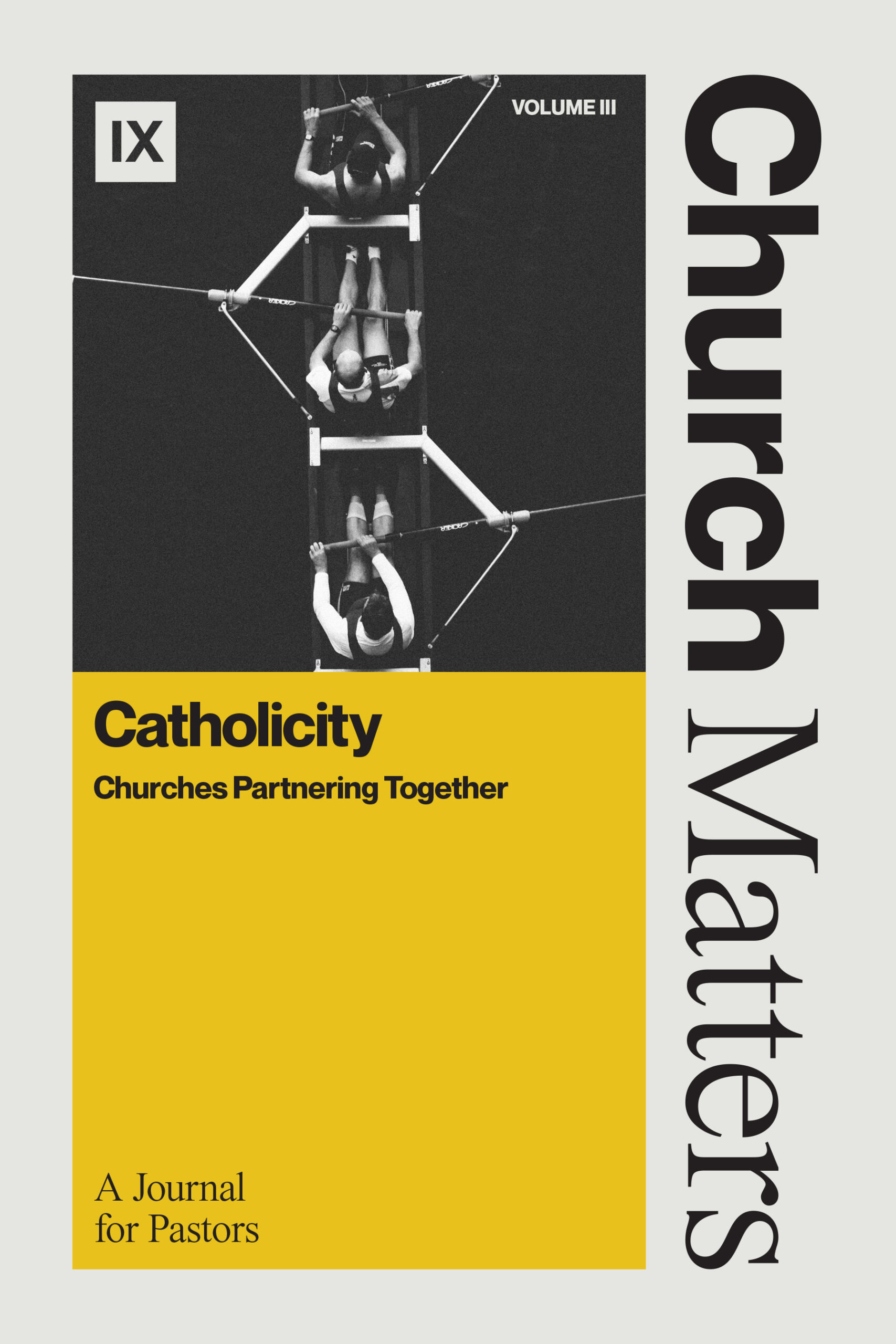What Is Catholicity and What Does It Require?
What do our churches mean by “catholic” when we recite the Nicene creed (381) and declare our belief in the one, holy, catholic, and apostolic church?
No, we don’t mean the Roman Catholic Church. That’s an instance of one particular organization inserting the adjective into its name. And the claim that they alone are the catholic church is, ironically, uncatholic.
Etymologically, the English word derives from the Greek katholikos, which combines the preposition kata (meaning, with respect to) with the noun holos (meaning, whole), as in, with respect to the whole.
The Indicative of Catholicity—What It Is
Theologically, however, we start with the gospel. The gospel is the good news that Jesus is gathering to himself a people from every tribe, tongue, and nation through the new covenant in his blood. As such, Christ’s church—this gathering—is and will be comprised of people from all the earth. It’s a global people. When we declare our churches “catholic” in a Sunday morning gathering, we are declaring something about the nature of those individual gatherings thanks to the gospel. We are saying that our local gatherings, by gospel nature and design, belong to a global or universal gathering.
That which we behold with the eyes of flesh, namely, the local gathering, is a manifestation or outpost of something we can only behold with the eyes of faith, namely, the catholic or universal church. To call the church catholic, then, is a statement of anti-independence, of connectedness, of inter-dependence between each congregation and the many. “For each fire is all fires,” observes the narrator in a Cormac McCarthy novel. Analogously, each church is all churches.
In that regard, the doctrine of catholicity functions like the doctrine of the church’s unity, only in obverse fashion. If the doctrine of unity declares that the many are one, the doctrine of catholicity declares the one are many. The obverse nature of these two doctrines explains why conversations about one can often sound like conversations about the other. They fade back and forth. “The one is many,” we declare, affirming the doctrine of catholicity. Yet just as quickly we feel compelled to add, “Of course the many are one,” and so affirm the doctrine of unity.
The declaration that the one is many and global and universal is not merely a quantitative declaration. It’s a qualitative one, too.[1] The many are not just many, they are diverse and eclectic and multicolored, hailing from every tribe, tongue, and nation, or at least the church is moving in that direction as we move toward the eschaton. A racist or nationalist church, in other words, is anti-catholic and therefore anti-gospel.
To summarize, then, the doctrine of catholicity declares that King Jesus is gathering to himself a people from every tribe, tongue, and nation through his new covenant, and that this new covenant people, the church, is therefore a global and multifarious people, as expressed increasingly with and inside of every local congregation.
The Imperative of Catholicity—What It Requires
Yet all this talk belongs to what biblical theologians call the “indicative.” The church is catholic in its nature. Yet the biblical theologians also remind us that imperatives follow indicatives. We’re commanded to become what we are.
Insofar as the doctrine of catholicity speaks about the church and not the individual Christian, the imperatives speak to whole churches and the relationship between churches. Applications to the individual Christian derive from the commands given to churches.
Specifically, the imperative of catholicity is the covenantal and missional demand placed on individual churches to recognize and partner with other gospel-preaching churches around the world as occasion allows and in a manner appropriate to the Bible’s institutional mandates for churches.
Let’s unpack each part of that.
1) First, the demand of catholicity is a covenantal demand. That is, it is grounded in our covenantal union with Christ. When a man adopts two boys from an orphanage, they become brothers by virtue of the shared adoption to him (see Eph. 2:11-22; 1 Pet. 2:10). This means those two boys possess a set of obligations to one another by virtue of their more fundamental union with their adopted father. So with every true church united to Christ. Each possesses some set of obligations to the others by virtue of their shared union with Christ.
2) Second, it is a missional demand. It is grounded not only in what makes the many one (the new covenant), but in the new covenant’s disciple-making impulse to push outward into all nations so that the one might be many, reaching as far on earth as Christ’s elect people reach and will reach.
3) Third, it is a demand to recognize other churches as churches. “That’s your brother. Look out for him,” my dad might have said to me if I was neglecting my younger brother at school. Notice that he starts with an assertion of shared identity. The command to recognize our shared brotherly identity is the first command from which all the other commands like “Look out for him” or “Don’t let him get bullied” or “Encourage him in the hallway” flow. Likewise, churches should look for ways to affirm and recognize one another as churches—as members of the same heavenly family.
4) Fourth, it is a demand to partner with other churches. If we’re all family members with the same mission, we should look for ways to work together. We’re stronger together than apart. Catholic churches and pastors, therefore, should be anti-turfy. The catholic pastor doesn’t want to build his own little kingdom. He recognizes instead that his church is not the heavenly kingdom, but an outpost or embassy of it. His desire to build and promote Christ’s kingdom, as such, means partnering with other embassies, other churches.
Like the U.S. embassy under attack in one nation calling for help from the U.S. embassy in a next-door nation, so catholic churches pray for one another, encourage one another, resource and supply one another. “The churches in the province of Asia send you greetings” (Rom. 16:5), writes the catholic Paul. “Your abundance at the present time should supply their need, so that their abundance may supply your need,” he says about two other churches (2 Cor. 8:14). The equally catholic John pipes in, “Therefore, we ought to support people like these, that we may be fellow workers for the truth” (3 John 8).
5) Fifth, it is a demand to recognize and partner with gospel preaching churches. A right doctrine of catholicity, in other words, is Protestant. It roots in a shared view of the gospel, not in a shared view of the ordinances or church structure. The Baptist church can recognize and partner with a Presbyterian church, and an Anglican with a Lutheran, because all share the same gospel.
Furthermore, this demand to recognize and partner with gospel preaching churches means that any refusal to recognize or partner with churches along nationalist or ethnically-exclusive or ideological reasons is expressly forbidden, since such divisions tear against gospel unity. The call to recognize and affirm more and more gospel-preaching churches does not mean more and more people who look just like us—in my case, American, white, and middle-class. It means more Christians, more Jesus followers, more gospel believers of every stripe and shade. Our catholic convictions should yield a diversity impulse. Quantitative and qualitative impulses feed each other. The desire for more is the desire for more of every kind.
6) Sixth, it is a demand to be heeded as occasion allows. While negative prohibitions like “you shall not murder” must be obeyed uniformly, positive injunctions like “Be fruitful and multiply” require the right time and place as determined by the considerations of wisdom. So with the general obligation for a church to partner with other churches, particularly since any given church can only afford a limited number of partnerships. First Baptist Church might wisely decide to partner with Emmanuel Grace in sending a missionary to Madagascar while wisely forgo Second Baptist’s offer to co-host a pastor’s conference.
7) Seventh, it is a demand to be heeded in a manner appropriate to the Bible’s institutional mandates for churches. Presbyterians and Anglicans, for instance, believe that the Bible mandates an institutional unity between churches. This vision of institutional unity will then be accompanied by a vision of institutional catholicity. The one church will seek to recognize and partner with the many primarily through the presbytery, the general assembly, the synod, and so forth. Baptists and Bible churches, on the other hand, believe the Bible mandates institutional independence. The one church will then seek to recognize and partner with the many churches in more informal (i.e. non-institutional) ways. Yet hopefully all can agree that the imperative of catholicity is a demand to recognize and partner with other churches in a manner appropriate to the Bible’s instructions on church polity, whatever we might think those happen to be.
Conclusion
The Bible’s Great Commission texts, in short, are its catholic texts.[2] They provoke our spiritual stomachs to hunger for more people to know Jesus.
Its corporate image texts are catholic texts. They remind us that to be a Christian is to be covenantally united with other Christians.[3]
That further means, the texts that picture churches partnering together are also catholic texts, because partnering with other churches is how we will fulfill the Great Commission.[4]
Finally, those texts which forbid us from building on anything other than Christ, such as Jewish identity, are also catholic texts, because our catholic convictions seek out a people from every tribe, tongue, and nation to give praise to the one who possesses all authority in heaven and on earth.[5]
* * * * *
[1] Thanks to C. Ryan Fields for this insight. Local and Universal: A Free Church Account of Ecclesial Catholicity (IVP, forthcoming 2024).
[2] E.g. Matt. 28:18-20; Acts 1:8.
[3] E.g. John 10:16; 1 Cor. 12:12-26; 1 Tim. 5:1-2.
[4] E.g. Acts 14:21-23; 15:25-26; Rom. 16:5, 16; 1 Cor. 16:1-3; 9; 2 Cor. 8:18; 9:12; 13:13; Eph. 1:15; 4:22; 6:18; Col. 1:4; 1 Thess. 1:7; 2:14; 2 Thess. 1:4; 2 John 7-8a; 3 John 5-6a.
[5] E.g. Acts 15; Gal. 2.
Related Multimedia











